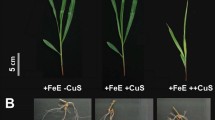Summary
Because copper is extremely important to the development of normal polllen, an attempt was made to induce male sterility in wheat by applying specific copper-binding ligands to wheat plants. Four different chelates were used at two rates in three methods of application. All four chelates, cupferron, neocuproine, benzotriazole and cuprizone, reduced grain yield at high concentration applied to the soil at sowing but benzotriazole was most effective, even when applied at late tillering to either soil or foliage, and it also reduced yield to a lesser extent when applied at low concentration. At high concentration of benzotriazole (50 mg kg-1 of dry soil) the percentage of pollen staining with I2/KI was very low (0–7%) depending on method of chelate application), and this soil treatment resulted in complete male sterility. The appearance of the pollen, anthers, grain, ears and leaves in many cases mimicked that of normal copper deficiency, and also that caused by other recognised gametocides. These results raise the question of whether binding of copper or some other disturbance of copper metabolism may be the mechanism by which andro-gametocidal chemicals work and if so, dictate a theoretical basis for selecting such chemicals for testing.
Similar content being viewed by others
References
Anderson, G. D. & R. D. Graham, 1980. Biennial Report of the Waite Agricultural Research Institute, University of Adelaide, 1978–79, pp. 59–60.
Colhoun, C. W. & M. W., Steer, 1982. Gametocide induction of male sterility: a review and observations on the site of action in the anther. Revue de Cytologie et de Biologie Vegetales le Botaniste 5: 283–302.
Colhoun, C. W. & M. W., Steer, 1983. The cytological effects of the gametocides Ethrel and RH-531 on microsporogenesis in barley (Hordeum vulgare L.) Plant Cell & Environment 6: 21–29.
Fries, J. & H., Getrost, 1977. Organic reagents for trace analysis. 453 pp. E. Merck, Darmstadt.
Graham, R. D., 1976. Male sterility in wheat plants deficient in copper. Nature 254: 514–515.
Graham, R. D., 1976. Physiological aspects of time of application of copper to wheat plants. J. Exp. Bot. 27: 717–724.
Graham, R. D. & E. K. S., Nambiar, 1981. Advances in research on copper deficiency in cereals. Aust. J. Agric. Res. 32: 1009–1037.
Graham, R. D. & D. T., Pearce, 1979. The sensitivity of hexaploid and octoploid triticales and their parent species to copper deficiency. Aust. J. Agric. Res. 30: 791–799.
Harry, S. P. & Graham, R. D., 1981. Tolerance of triticale, wheat and rye to copper deficiency and low and high soil pH. J. Plant Nutr. 3: 721–730.
O'Sullivan, W. J., 1969. Stability constants of metal complexes. In: Dawson, R. M. C., D. C., Elliot, W. H., Elliot & K. M., Jones (Eds), Data for biochemical research. Oxford U.P., London, 2nd. ed.
Author information
Authors and Affiliations
Rights and permissions
About this article
Cite this article
Graham, R.D. Induction of male sterility in wheat using organic ligands with high specificity for binding copper. Euphytica 35, 621–629 (1986). https://doi.org/10.1007/BF00021871
Received:
Issue Date:
DOI: https://doi.org/10.1007/BF00021871




